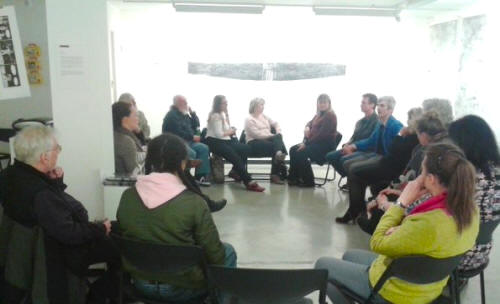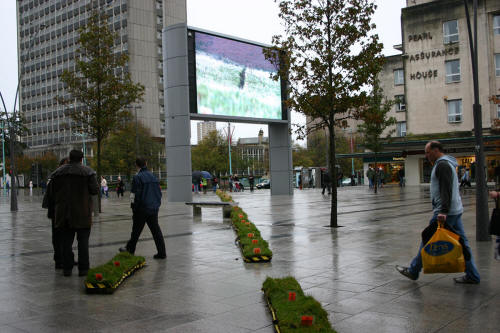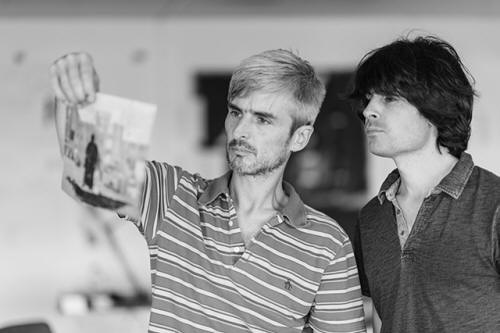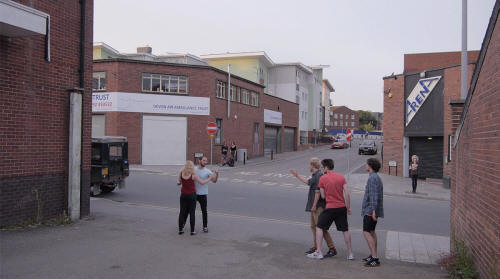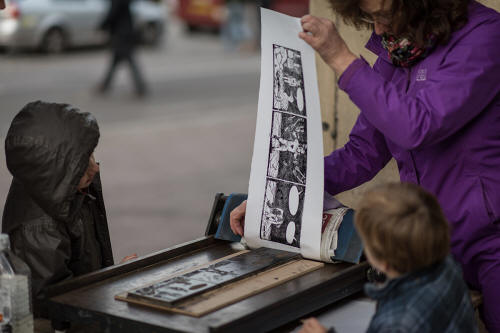|
|
| home | exhibitions | interviews | features | profiles | webprojects | archive |
|
TOPOS Alex Murdin on the Exeter-based studio, exhibition and event space initiated by artist Volkhardt Müller
Topos:
ancient Greek for “place” Topography:
the configuration of a surface including its
relief and the position of its natural and man-made features: the art or
science of making maps that show the height, shape, etc., of the land in
a particular area.
"…an art world that continues to
privilege the city as the only relevant site of art practice and
dissemination (evident in the tendency to identify major
biennial exhibitions with particular cities, and in the ongoing
relationship between new museum construction and the process of
urban redevelopment). As Kane-Sy writes, "it is habitual to
think that art may, and must, rhyme with urban existence alone.”
The core/periphery logic of globalization thus reiterates a more
general prejudice within the discourse of modernism that
contrasts the city, as the site of an advanced, cosmopolitan
culture, with the conservatism, stagnation, and idiocy, in
Marx’s famous words, of rural life." (Grant Kester, 2011) To live and work in a place like Exeter in
Devon is to know this basic binary of urban and rural as false. Although
as a city Exeter might see the rural hinterland of Dartmoor and North
Devon as peripheral, Exeter itself is experienced as peripheral to
larger cities, Bristol, Birmingham, and London, and therefore both
central and on the edge at the same time. Perhaps this is why there has
been for some time a sense of cultural crisis in Exeter which, as the
political capital of Devon, has always seen itself as a hub for culture
but now has increasing competition from other places like Plymouth, such
that the: “chief issue facing Exeter in its cultural role is whether it
is able to raise its game and become a genuinely regional cultural
centre” (Exeter City Council, 2003)
Topology (n): the (mathematical) study of geometric properties and spatial relations unaffected by the continuous change of shape or size of figure.
TOPOS was conceived by Müller in this sense as a topological experiment, as a city studio space that was not a retreat , but a specific location that connected him topologically to the publics surrounding it. Over the following year a folding of the map occurred through a series of public conversations and participatory interventions. Distances were shortened and new connections made between sound artists and farmers, meteorologists and furniture designers, architects and cultural geographers, printmakers and foresters, regardless of boundaries. In order to catalyse these conversations four artists, writers and performers, Sean Borodale, Dawn Scarfe, Josie Sutcliffe and I, made work in response to these conversations with Volkhardt and others. There was no doubt about the energy created within the space, as Müller says:“The permeability of the space, the many informal visits by people, the intensity of engagement when they come. What's striking in public showings is that people commit themselves to the space and the work often for hours.” Topical (adv): of, relating to, or arranged by topics; referring to the topics of the day or place; of local or temporary interest The material and history of this place also had an agency in these conversations. Sidwell Street is an unassuming shopping street at the north-eastern end of the centre of Exeter, a mixture of mostly independent outfits - butchers, hairdressers, a pound shop, hairdressers, bars, fast food joints, hardware, pets, musical instruments, ethnic grocers, charity shops, a small market and a Methodist church - St Sidwells. The current buildings were built in the bomb damaged debris of the medieval East Gate area in the post-war period. The 50’s architecture is of red brick and concrete with neo-classical details like columned arcades. It was part of a hopeful plan for rebuilding the city started by town planner Thomas Sharp in 1946, called “Exeter’s Phoenix”. This was a period of optimism, of dreams of technology creating a better life but there was often a price for this modernist optimism: “This is concrete, I don’t know what you think about concrete but it’s an extraordinary material, developed by material scientists so that it’s a very complex thing using silicates, calcium hydroxides, rebar, very cleverly engineered, but it’s mass produced and it’s developed in a way that’s very easy for builders and constructors to use… any gumby can use it. But if you go down the road there, there’s a church, St Sidwell’s, that’s made out of concrete it’s [one of] the first reinforced concrete buildings in this country… what looks like stonework is all pre-cast concrete which was developed in France, Montpelier, and then moved over here. Obviously a lot more design, beauty and time is involved, and passion, but… the builder went bust… and the architect went mad.” Participant in Quality and Alchemy public discussion at TOPOS.In the present day Sidwell Street looks distressed and is a stark contrast to the adjacent wealthier Princesshay shopping centre which was similarly rebuilt as Britain’s first pedestrianised shopping precinct in 1949, but more recently redeveloped into modern shopping mall in 2007 in a post-modern style of glass, steel and stone cladding. Now Sidwell Street is the subject of similar regeneration plans. So TOPOS has taken place in an environment in a state of undecided potential for change which throws its history, social and economic make-up into sharp relief as this place’s future is considered – what to keep, what to throw away, who will stay, who will go ?Utopia (n) (ancient Greek meaning “no-place”): an imaginary island described in Sir Thomas More's Utopia (1516) as enjoying perfection in law, politics, etc: hence an ideal place or state; any visionary system of political or social perfection.
Martin Self: “the gothic ruin… [is] the ruin of a lost past.. whereas the ruin of a modernist building is quite powerful and uncanny… the idea that its actually the ruin of a lost future” John Wylie: “[Utopias are]… nostalgic of the past but also… nostalgic of the future, there’s a famous short story by William Gibson, it’s called The Gernsback Continuum, it’s about this guy who starts to suffer a whole series of hallucinations in which the Flash Gordon world of the 30’s through to the 50’s has actually come to life, the story is about a future that never came to be, the one that haunts our dreams as much as any kind of notion of utopia being backwards or nostalgic.” Volkhardt Müller: “there is also the Arcadian dream, a bit of an English thing… a backwards dream of a better future…” Shroud and other works made at TOPOS connect these ruins and dreams as Sidwell Street moves between its history - a rise from the ashes of the Second World War and a first bright future of shopping and plenty, its impoverished present and its possible future - its imminent demolition and the recurring dream of another future of prosperity created by current plans for redevelopment. D ystopia (n): The opposite of utopia. An imagined place or state in which everything is unpleasant or bad, for example a totalitarian state or environmentally degraded place.As the memory of the building, its future past, makes the TOPOS space uncanny (un-homelike), so too does its functional usage. It is part of a retail infrastructure of shopping, which makes it a sort of in-between space, a conduit for the distribution of goods, where they were received, labelled, sorted and stored before they were sent out for public consumption. It is a place in-between the maker and the user. Because of this it is a type of hidden space for passing things through, like an air duct, a road or a data cable:: “The in-betweeness of infrastructural industrial and commercial spaces is also an aesthetic space: we can all think of any number of fairy tales, horror films or “duct films” like Die Hard or Alien where there are ghosts, terrorists or other things in the attic, basement, walls or service infrastructure. These are places which we sense with our hearing as we listen to the sounds of uninvited animals like rats, spiders, cockroaches and bats, or from which a strange smell comes, or of which we only catch a glimpse of as the curtains twitch. These are unknown sites within the known boundaries of familiar habitation, like home or work, which are therefore uncanny, understood but strange at the same time. This known unknown is a differentiated aesthetic space and is therefore becomes an “ideal place for utopian dreaming” for the artist, who after all is used to the garrets of old.” Alex Murdin (2015)
“My sense was of existing for five days IN the membrane between the artists’ thinking/making/working space and the immediate proximity to the city streets outside… The influence of the city upon the artist, the forays the artist makes into the city; living for a week intensely in the permeable space that a studio is has put a pressure on thinking – making as thinking - and it forced our dialogue into a space which, to me, felt like it lay inside the depth of a mirror-glass in which reflection happens; reflection compressed to an intensity in the moment of making.” The image and words that Müller and Borodale saw in the mirror circulate around a dark figure (a figurine of a black monk brought into the studio by Borodale) which appears in the artists’ book and video installation, The Monk by the TV (2015). In these works a still dark face or a silhouette appears on TV screens, in streets, at windows observing the cityscape, the shoppers and the transient life of the city street and embodying all the hidden urban fear of the criminal fugitive or terrorist plotter. The voyeuristic black monk is prefigured in a work made before TOPOS, Any High Street (2012), in which the last panel of these backlit woodcuts shows a scene observed by Müller of the dark side of city night life, its arguments, tears and the ever present threat of violence. Similarly the new video work by Müller, The Arena (2015), restages these night times scenes, acted by volunteer members of the public in a more innocent daytime setting (below). The films commence with the entrance of individual figures who assume dramatic (but static) poses found classical landscape paintings of rural scenes . As more actors enter from the wings and assume their positions a scene develops as a narrative snap shot from the previous night, set against a backdrop of passers-by and the streets of the city.Topos (n): a traditional, recurring or conventional literary or rhetorical theme or topic, as in commonplaces
“I’m often using glass objects that resonate at particular pitches to maybe draw sound out of the environment… arrange them spectrally so it’s trying to get this oscillation between foreground and background…” The results of their journey to the tree and the negotiation of their way over private property to reach this shared visual amenity were two works which connect foreground to background, centre to peripheral horizon. Eclipses (2015) is a performance, sound and video installation in which Müller on a far hillside tries to position a large white round disc in the sights of binoculars held by Scarfe who remains in the city and instructs Müller as to position by phone. Broadcasts From the Edge of the World (2015-) is a work in progress, a proposal for street conversations on the subject of the lone tree as part of a radio-based performance. Müller and Scarfe also share an interest in Romantic art and artists. Müller in particular speaks of the influence the painter Caspar David Friedrich has had on his work. Freidrich’s most well-known paintings include the Wanderer Above the Sea of Fog (1818) and The Hunter in the Forest (1813) in which figures with their backs to the viewer stand on the edge of a change of environment. The height of the climber who looks out over a sea of fog from a precipice and the hunter about to enter the dark forest in pursuit of quarry unknown are on the verge of something both great and fear-inducing. Müller describes this topological manoeuvre, a short-circuiting of fore and back grounds (essentially the same as that used in Eclipses and Broadcasts From the Edge of the World), as “The Romantic trajectory... standing in the foreground… they dream themselves into the background.” Topology (n): also, the way in which constituent parts are interrelated or arranged e.g. "the topology of a natural ecology, a society, a computer network etc" Volkhardt Müller: “The idea of the Bauhaus in the 1920’s… someone comes along and says how can we drive artistic processes and thinking through into mass production and produce goods that are cheap to be produced but that are very high quality standard and that are aesthetically pleasing. Why has that failed, because it has failed. There is some of that residual stuff going on, but as a mass phenomenon? The relevance of this for me is to do with sustainability, we simply can’t continue this… to churn things in and out, it’s like some crazy eating habit.” Paula Crutchlow: “But we can… because in the end what’s going to happen is we’ll just eat ourselves. Does it matter?” Printmaking is essentially a material concern. Paper or other similarly absorbent material, e.g. textile, is used to take an inked imprint of the surface of another material, a metal, wood, plastic, stone and so on. The print records the particularities of the material as well as the marks made by the artist which shape the conceptual content. Given that printmaking has been at the core of the artistic processes seen in to TOPOS, and that the studio is a former storeroom where material products are bought and sold, it is no surprise that many of the conversations within the space have set out to describe a history of materiality. What was discussed was the economic and cultural shift from the long-lived crafted utilitarian object, to the mass manufactured product endlessly digitally reproduced in “a near total flattening of everything down to this homogenised gloop of products”, to the way this means that objects are differentiated as an experience of enjoyment, freedom or empowerment - “MOVE WITHOUT LIMITS - Reach your max then reach for more in the quick cooling Nike Pro Hypercool Training Tight” , to the topical cultural, economic and political reassessment of provenance: “ingredients but also values… there’s no value to it if you don’t know where it’s from, you’ve got nothing invested in where that food’s come from, you don’t care that maybe on the other side of the world someone’s life is totally tied up in that…”. These discussions on the origin of materials meandered back to the landscape as the source of resource, where they had come from, the consequences of their extraction, their place in the wider ecology of human, animal, plant and mineral activity. This was a map of the interconnectedness of all of these agents in shaping a future where pressures on resource mount from the inexorable growth of the human population. - right) was a participatory print project by Müller and volunteer collaborators which took a printing press out onto Sidwell Street and invited the public to contribute to two simple comic strips. In the first set of three frames a child dashes toward a group of sea gulls eating discarded chips from the pavement in order to pick one up. This street scene sets up a relationship between human and animal which is sufficiently ambiguous to encourage a variety of responses. Was the child attacked by the gulls in the first place? Is she stealing the gulls food ? Is she about to clear up someone else’s rubbish? Whatever her motivation the speech bubbles (blank for participants to fill in) connect to the gulls, who are given a voice to express opinions on the girl’s actions. In one version one of the gulls turns the tables on the girl: “They are destroying the world and should be culled”. It is a simple action but participants have been able to empathise with the birds usually seen as pests, to see themselves as cohabiters of public space and as part of an ecological continuum. To see oneself in this way is to see public space as part of a set global biological connections, an idea first suggested by philosopher Michel Foucault:“With the emergence of mankind as a species, within a field of the definition of all living species, we can say that man appears in the first form of his integration within biology. From one direction, then, population is the human species, and from another it is what will be called the public. Here again, the word is not new, but its usage is. The public, which is a crucial notion in the eighteenth century, is the population seen under the aspect of its opinions, ways of doing things, forms of behaviour, customs, fears, prejudices, and requirements; it is what one gets a hold on through education, campaigns, and convictions. The population is therefore everything that extends from biological rootedness through the species up to the surface that gives one a hold provided by the public… From the species to the public; we have here a whole field of new realities in the sense that they are the pertinent elements for mechanisms of power, the pertinent space within which and regarding which one must act.” (Michel Foucault et al, 2007) Topical (adv): designed for or involving local application and action (as on the body, e.g. a topical anaesthetic). TOPOS then has existed both at the centre and the periphery of Exeter for over a year, physically as a space of infrastructure between public gallery and private studio, thematically in its discussion of the ecologies of the urban and the rural, socially as an observer of place and an actor in its regeneration and artistically as a mediator between individual expression and collaborative participation. As such it suggests a way forward in developing cultural infrastructure in regional cities like Exeter as part of a fluid set of non-traditional spaces which rely on catalysing agents, in this case led by artists, as well as (or instead of) focussing on traditional facilities such as galleries and theatres which are now facing even bigger challenges in sustaining their programmes. In this TOPOS exists in relation to a growing number of similar initiatives; the Serpentine Gallery’s Edgware Road Project which generated the Centre for Possible Studies in an empty shop in order to create a dialogue between international artists and local communities; Plymouth Arts Centre’s Project 11 in which artists occupied retail spaces in the commercial West End of the city. Mainstream recognition of these methods grows. Printmaker Ciara Phillips was nominated for the Turner Prize in 2014 for turning an art gallery, The Showroom, into an agitprop print resource in Workshop (2010 - ongoing) and in 2015 Assemble won the Turner Prize for their work in Toxteth, Liverpool with the Granby Four Streets Community Land Trust and Steinbeck Studios to the refurbish local terraced housing and public spaces with reclaimed, DIY features. These projects diffuse cultural activity from studio, to gallery, to public space, to commercial premises, to private home. What is perhaps unique about TOPOS though is that it takes in an expanded field of operation which encompasses both city and countryside, recognising that both of these cultural spaces are equally central to a globally connected society facing the challenges of a creating a sustainable future. In doing so it creates a space for a diversity of opinion and perspectives which nevertheless come together around a set of urgent concerns (the future of the city, the breaking down of its boundaries with the countryside and long term sustainability.). Perhaps what has been achieved by TOPOS so far is what Felix Guattari, a foundational philosopher of the ecological movement, has articulated as a joint objective which challenges consensus in a “fluidarity” of positions where: "…a plurality of disparate groups come together in a kind of unified disunity, a pragmatic solidarity without solidity” (Guattari, 1989: 10) .
|
|
|

